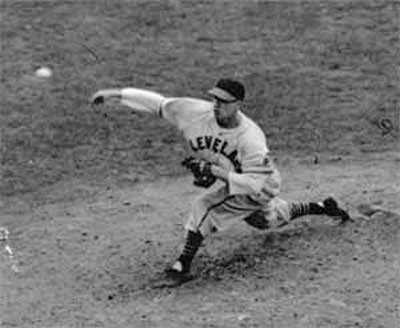 You know who Bob Feller is. The man was perhaps the dominant pitcher of baseball’s Golden Era, and spent the majority of his life enshrined in Cooperstown. He was an all-time great pitcher, and a perfect example of a baseball phenom.
You know who Bob Feller is. The man was perhaps the dominant pitcher of baseball’s Golden Era, and spent the majority of his life enshrined in Cooperstown. He was an all-time great pitcher, and a perfect example of a baseball phenom. Feller was born and raised in Van Meter Iowa in 1918. Before the 1936 season, at 17, he was signed, infamously, by scout Cy Slapnicka for $1 and an autographed baseball. There was a short fiasco about Feller being placed on rosters for several different Indians’ minor league teams, but he eventually landed on the Indians’ roster and on July 19 he pitched a shutout inning against the Washington Senators. He would continue to pitch effectively, posting a 3.34 ERA, but the highlight of his season, and maybe his career, was a 17-strikeout performance versus the Philadelphia Athletics on September 13. Still at 17 years of age. 
Feller’s calling card was his fastball. Before Aroldis Chapman and Nolan Ryan and Steve Dalkowski were lighting up radar guns, the world speculated on how fast ‘the Heater from Van Meter’ could throw. Feller himself claimed that he once hit 107.9 mph at a demonstration in 1946, and was also clocked at 104 mph in Chicago’s Lincoln Park. While these are mere claims, and methods of measuring pitch speed at the time are suspect at best, it is safe to assume he could throw well over 100 mph. In this video, Feller is, later in his career, after throwing 300-370 innings per year for a decade plus offseason barnstorming, hitting 98.6 mph. This measurement was taken at the plate, as opposed to the modern method of measuring the ball out of the pitchers’ hand. Feller was throwing well over 100 mph in that video, and one can only speculate how fast he would have been throwing in his prime.
Feller put that fastball to good use. He immediately set the American League on fire. He posted a 3.38 ERA over 210 IP in ’36-’37, then on October 2, 1938, struck out 18 Detroit Tigers, then a record for a 9-inning game. On Opening Day, 1940, he threw the only Opening Day no-hitter in MLB history. It was at this point, still just 20 years old, that Feller would enter his prime. From 1939-1941, Feller would average 25 wins, a 2.88 ERA, and 256 K’s in 320 IP. He instilled fear into opposing hitters. Ted Williams said he had the best stuff he ever saw in a career that spanned over two decades. Stan Musial called him the greatest pitcher of that era. Iowans were crazy about this dazzling young local kid. He was, in every sense of the word, a phenomenon.
He would miss most of five seasons serving in the US Navy during WWII, but would make 9 starts at the tail end of 1945. He picked up where he left off, and from 1945-1948, put up a 2.73 ERA (in one of the most offensively-charged periods in the history of the game) in 1024 IP. He averaged 39 starts, 317 IP and 236 K’s from ’46-’48. In 1946 he struck out 348 men.
1949 would mark the end of Feller’s dominance. Just 30 years old, he made 28 starts, posting a 3.75 ERA as years of abuse began to catch up with him. Over the rest of his career, (1949-1956) Feller would remain effective, though the performances of his prime were clearly in the rear-view mirror. Over this time, he posted a 3.73 ERA, about an average rate, while averaging only 170 IP per season. In 1956 , at 37 years of age, he was finished as a starter. He made 4 starts in 19 appearances, posted a 4.97 ERA, and hung up his cleats.
, at 37 years of age, he was finished as a starter. He made 4 starts in 19 appearances, posted a 4.97 ERA, and hung up his cleats.
In 1962 he was inducted into the National Baseball Hall of Fame on 94% of the BBWAA ballot. Feller would remain a familiar face around baseball over the next 50 years, making many appearances and acting as a goodwill ambassador for the Indians and MLB. In 2009 at 90 years of age, he pitched in the Baseball Hall of Fame Classic. The ensuing year, however, affected by leukemia and thrush, Feller would pass away on December 15, aged 92.
Feller accomplished more as a teenager than many do in their careers, and pitched better before turning 29 than many Hall of Famers manage at any point in their careers. Feller’s fastball made him a myth, his success, a legend, but the excitement he garnered as a 17-year old with the best fastball in a generation of the sport makes him the embodiment of a baseball phenom.
Tidak ada komentar:
Posting Komentar